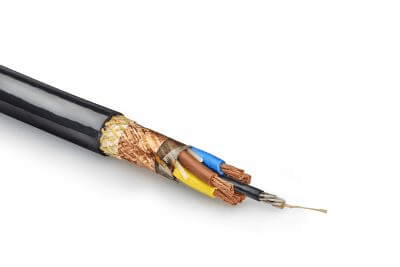What Is a Shielded Cable?
 A shielded cable is a cable in which the metal conductor portion that transmits signals and power is covered with a grounded metal layer.
A shielded cable is a cable in which the metal conductor portion that transmits signals and power is covered with a grounded metal layer.
The grounding metal layer is made of a thin film or other material that is braided into a structure. Covering the conductor section with a metallic layer blocks electromagnetic waves from the outside and, at the same time, prevents leakage of electromagnetic waves to the outside.
This structure contributes to high-speed communication in the communication and instrumentation fields and is important for ensuring safety in the high-power field. Multi-core cables also play a role in canceling out inter-wire noise.
Uses of Shielded Cables
Shielded cables are widely used in LAN cables for OA equipment and loudspeakers for audio equipment.
The purpose of these applications is to protect equipment from electromagnetic waves emitted from outside. In contrast, shielded cables are also used in high-voltage power distribution applications. The purpose of these applications is to prevent the generation of electromagnetic waves.
Principle of Shielded Cables
The main components of a shielded cable are the conductor, the shielding layer (shield), the insulation layer, and the sheath.
In ordinary metal cables, the outer conductor is covered by an insulating layer. Shielded cable, on the other hand, is covered with a shielding layer, such as a thin metal film, on top of the insulation layer covering the conductor.
The outside of the shielding layer is covered with an insulating film called a sheath to protect the wire from the outside environment. By grounding the shielding layer, signal cables can be protected from noise. Shielded cable can also be used for power cables to cancel out the electromagnetic waves generated.
Canceling electromagnetic waves from power cables is often used from a safety perspective because it leads to the prevention of electric shock accidents due to induction.
Types of Shielded Cable
Shielded cables include “electrostatic shielded cables,” which prevent external noise, and “electromagnetic shielded cables,” which prevent magnetic flux caused by electric current from affecting external equipment. Since the method of grounding the shielding layer differs depending on the type, it is important to ground the cable using a method appropriate for the type.
1. Electrostatic Shielded Cable
Electrostatic shielded cable is a cable with a core wire covered with metallic tape, such as copper or aluminum, or mesh braided wire.
This absorbs external noise and conducts it to ground, preventing noise from entering the core wire. It is mainly used for signal and communication cables. The basic grounding method for electrostatically seeded cables is single end grounding. This is to prevent the return current from flowing into the shield.
If both ends are connected to ground, there is a greater possibility of current flowing through the shield, and there is a risk of noise being generated from the shield due to current flow. Also, if the shield is not connected to ground, not only will the shield not be effective, but the electrical charge accumulated in the shield will be released in some way, causing noise in the signal, so care must be taken. When shielded cable is used, it must be grounded.
2. Electromagnetic Shielded Cable
Electromagnetic shielded cable is a cable with a core wire covered with iron and copper to prevent magnetic flux caused by electric current from escaping.
The disadvantage of this cable is that it is vulnerable to bending and folding due to the iron covering. It is mainly used for power cables, motors, and other cables in which large currents flow. When grounding an electromagnetically shielded cable, choose between grounding at both ends or at one end, depending on the distance. For long-distance power transmission, grounding should be done at both ends, and for short distances, grounding should be done at one end. In both cases, the grounding wiring should have as low electrical resistance as possible to increase the shielding effect.
Generally, copper plates or copper piles are embedded several meters underground to reduce grounding resistance. This underground buried conductor is the grounding pole. Wires rising to the ground surface from the grounding pole are connected to a copper bar called a ground bar or bus bar.